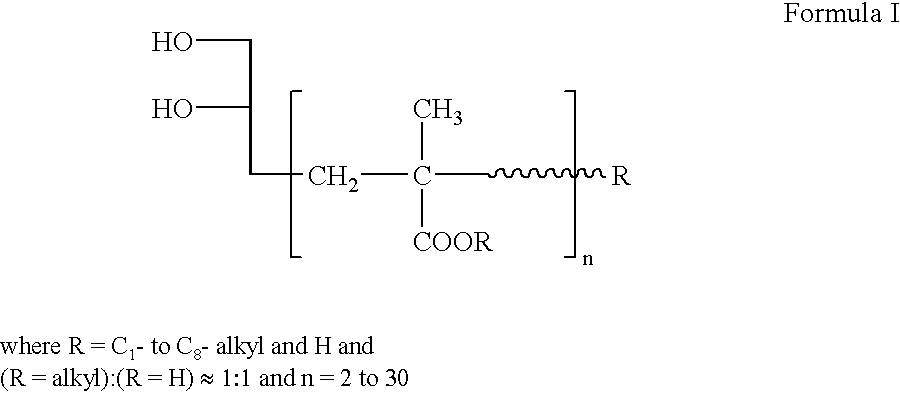Polyurethane dispersion with high film hardness, process for preparing it, and its use
a polyurethane and film hardness technology, applied in the direction of polyurea/polyurethane coatings, coatings, etc., can solve the problems of inability to control the ratio of soft segments to hard segments, inability to achieve simultaneous controlled influence of flexibility, hardness, dispersion stability, etc., to achieve high hardness, good chemical resistance, and high flexibility of crack-free films
- Summary
- Abstract
- Description
- Claims
- Application Information
AI Technical Summary
Benefits of technology
Problems solved by technology
Method used
Image
Examples
example 1
Polyurethane Dispersion B
[0057] 1) Polyurethane Resin P2:
[0058] A four-necked flask equipped with KPG stirrer, reflux condenser, thermometer and nitrogen blanketing was charged with 360.0 g of TEGO.RTM. Diol BD1000 (.alpha.,.omega.-polybutyl methacrylate diol of molar mass 1 000 g / mol from Tego Chemie Service GmbH), 5.9 g of neopentyl glycol (NPG from Neste Chemicals), 290.0 g of dispersing diol P (in accordance with preparation described) and 70.0 g of methyl ethyl ketone (MEK). After heating to 60.degree. C., the catalyst solution, 6.0 g of dibutyltin oxide solution (5% strength in MEK), was added. 175.4 g of isophorone diisocyanate were added over the course of 1 hour. The mixture was heated to 85.degree. C. and the course of reaction was followed by monitoring the NCO value. The course of the reaction was followed by acidimetry. After the end of the polyaddition reaction, an NCO content of approximately 1.4% by weight was found. 18.9 g of trimethylolpropane (from Aldrich) and 2....
example 2
Polyurethane Hybrid Dispersion
[0069] 300 g of the polyurethane dispersion (example 1) were charged to the reaction vessel at room temperature and were diluted with 122 g of demineralized water, with uniform stirring. 2 ml of aqueous ammonia solution (25% strength) were added until a pH of about 8.0 was reached. 15.7 g of n-butyl acrylate (BA), 89.3 g of methyl methacrylate (MA) and 1.33 g of 2,2'-azoisobutyronitrile (AIBN) were mixed well separately in a vessel at room temperature and were added to the polyurethane dispersion over 90 to 120 minutes. When all of the monomer / initiator solution had been added, the dispersion was heated at from 80 to 82.degree. C. and held at this temperature for 5 hours. The dispersion was then cooled to 25.degree. C. and filtered through a filter (pore size 80 .mu.m). This gave a fine opaque hybrid dispersion having a solids content of about 35% by weight.
PUM
| Property | Measurement | Unit |
|---|---|---|
| molecular mass | aaaaa | aaaaa |
| molecular mass | aaaaa | aaaaa |
| decomposition temperature | aaaaa | aaaaa |
Abstract
Description
Claims
Application Information
 Login to View More
Login to View More - R&D
- Intellectual Property
- Life Sciences
- Materials
- Tech Scout
- Unparalleled Data Quality
- Higher Quality Content
- 60% Fewer Hallucinations
Browse by: Latest US Patents, China's latest patents, Technical Efficacy Thesaurus, Application Domain, Technology Topic, Popular Technical Reports.
© 2025 PatSnap. All rights reserved.Legal|Privacy policy|Modern Slavery Act Transparency Statement|Sitemap|About US| Contact US: help@patsnap.com

